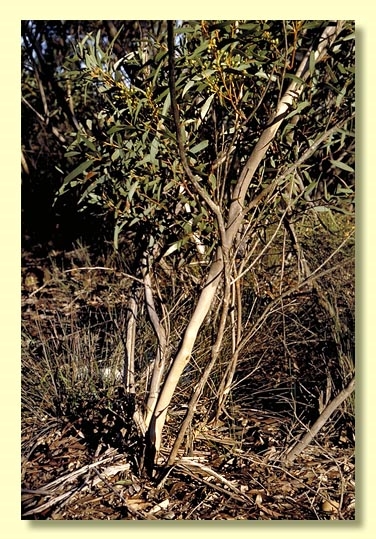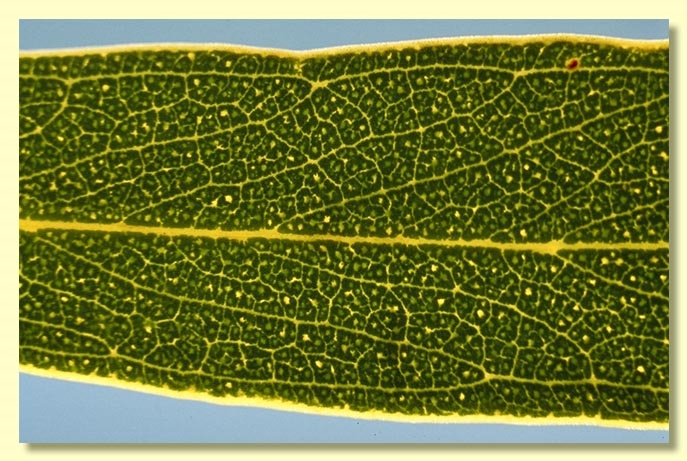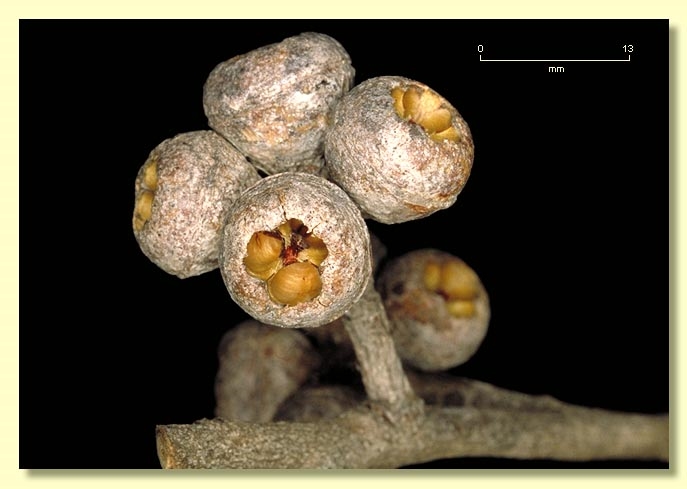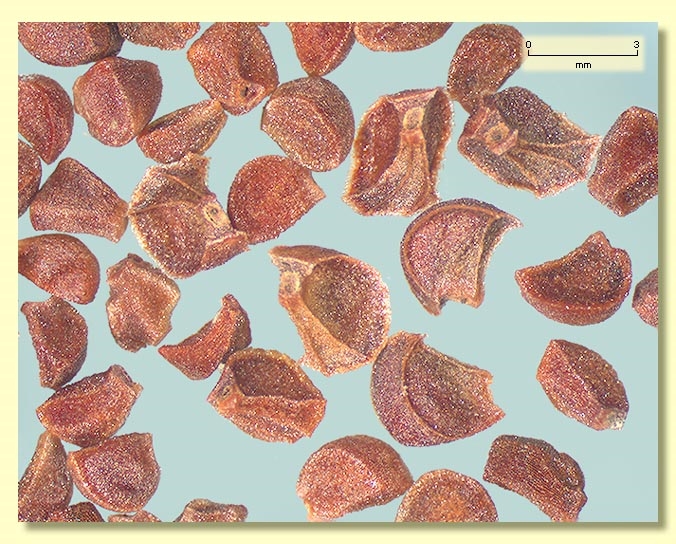Eucalyptus | Eucalyptus | Longistylus | Frutices | Diversiformae | Neuropterae
Euclid - Online edition
Eucalyptus pachyloma
T: Swan R. Colony, W.A., 1845, J.Drummond 64; syn: BM, CGE, E, FI, G, K, MEL, NSW, PERTH, W; Kalgan R., W.A., A.Oldfield 324; syn: G; Stirling Ra., W.A., G.Maxwell; syn: K, MEL.
Bark smooth, grey to grey-brown and greenish.
Branchlets lacking oil glands in the pith.
Juvenile growth (coppice or field seedlings to 50 cm): stems rounded in cross-section; juvenile leaves held erect, sessile and opposite for ca 3 nodes on field coppice then becoming petiolate and alternate, narrowly elliptic to narrowly oblong, then lanceolate, 4–8 cm long, 0.9–2 cm wide, blue-green, gradually becoming glossy, green.
Adult leaves alternate, erect, petioles 0.5–1.2 cm long; blade usualy lanceolate, 5.8–10.8 cm long, 0.7–1.3(1.8) cm wide, base tapering to petiole, margin entire, apex pointed, concolorous, glossy, green, side-veins usually at an acute, reticulation moderate, intramarginal vein remote from margin, oil glands irregular in outline, island.
Inflorescence axillary unbranched, peduncles stout, 0.5–2 cm long, buds 7 to ?13 per umbel, pedicels 0.1–0.4 cm long. Mature buds ovoid to globular, 0.7–1 cm long, 0.6–0.9 cm wide, scar absent, the single operculum conical to rounded, stamens irregularly flexed (outer flexed tangentially, inner more or less inflexed), anthers ± cuboid, versatile, dorsifixed, dehiscing by longitudinal slits that are not or scarcely confluent apically, style long and straight, stigma tapered, locules 3, the placentae each with 2 vertical rows of ovules. Flowers white.
Fruit sessile or on pedicels to 0.3 cm long, broadly cupular to obconical, 0.7–1.1 cm long, 1.2–1.7 cm wide, disc slightly raised and convex to oblique, valves 3, at rim level.
Seeds brown, 2.5–3.5 mm long, pyramidal to D-shaped, dorsal surface smooth, margin narrowly flanged, sides ribbed, hilum terminal.
Cultivated seedlings (measured at ca node 10): cotyledons reniform to orbicular, large; stems rounded in cross-section, warty/scabrid for lower ca 2 to 4 internodes then smooth; leaves opposite, sessile, amplexicaul, ovate for ca 4 to 6 nodes then bases rounded to tapering and shortly petiolate, alternate by ca node 7–10, lanceolate, 5–10 cm long, (1)2–3 cm wide, dull, discolorous at lower nodes, concolorous when alternate, green, never scabrid.
Flowering has been recorded in October, December and January.
A mallee endemic to Western Australia. It is found on the sandplains south-east of Perth from Tutanning and Narrogin to the Stirling Range National Park and immediately east thereof. The bark is smooth and the adult leaves glossy green and held erect.
Eucalyptus pachyloma belongs in Eucalyptus subgenus Eucalyptus series Diversiformae, a group of mallee species characterised by adult leaves held more or less erect, buds with a single operculum (hence no operculum scar), cuboid-oblong anthers that shed pollen by two separate slits, ovules arranged in two rows on the placenta, pyramidal seed and seedling leaves opposite for some pairs. The species in series Diversiformae are E. pachyloma, E. erectifolia, E. platydisca, E. diversifolia, E. todtiana, E. lateritica, E. dolorosa, E. buprestium,
E. pachyloma has narrowly flanged seed, a character shared with two related species, E. buprestium and E. erectifolia with which it is sympatric. These three species can be separated on fruit features—E. buprestium has large spherical fruit with descending disc; E. pachyloma has cupular-obconical fruit with raised disc; E. erectifolia has a cupular fruit with more or less level disc. The leaves of E. pachyloma are held erect and are rather stiff. This and the cupular fruit with broad disc suggest a distant relationship with E. platydisca from near Norseman; however, that species lacks the marginal flange on the seed. The more northerly distributed E. dolorosa differs in having some basal rough bark and apparently terminal inflorescences (inflorescences axillary in the other species mentioned here). E. diversifolia (2 subspecies) which occurs occurs along the souther Ausatralian coastline from Majura (Western Australia) east to Cape Nelson (Victoria), and has more or less rhomboid buds and seed not or scarcely flanged. The coastal sandplain species E. todtiana and E. lateritica, differ in the extensive rough bark and larger cupular fruit.














